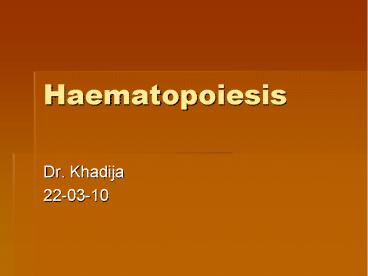Haematopoiesis - PowerPoint PPT Presentation
Title:
Haematopoiesis
Description:
Angiogenesis is the formation of new vessels by budding and branching from preexisting vessels Vasculogenesis Angiogenesis Mesenchymal cells ... – PowerPoint PPT presentation
Number of Views:417
Avg rating:3.0/5.0
Title: Haematopoiesis
1
Haematopoiesis
- Dr. Khadija
- 22-03-10
2
- PHASES OF HAEMOPOIESIS
- SITES OF HAEMOPOIESIS
- BONE MARROW
3
Haemopoiesis
- A biological process in which new blood cells are
formed, and is usually taking place in the bone
marrow
4
Types of Cellular Elements
- Red blood cells Erythrocytes
- White blood cells Leukocytes
- Neutrophils
- Eosinophils
- Basophils
- Lymphocytes
- Monocytes
- Platelets Thrombocytes (not true cells)
5
GRANULOCYTES AGRANULOCYTES
6
Sites of Hematopoiesis
- In 2 week old embryo, hematopoiesis begins in
yolk sac. Production of erythrocytes first cells
7
(No Transcript)
8
- In 3rd-7th month, stem cells migrate to
- liver and spleen major site of fetal
- hematopoiesis.
9
- At birth and into adulthood confined to
- bone marrow (red marrow is active)
10
Extramedullary haemopoiesis
- Blood cell production in hematopoietic tissue
other than bone marrow. Occurs when hyperplasia
(increase in number of cells per volume of
tissue) of marrow cannot meet physiologic blood
needs of tissue. Principally occurs in liver and
spleen
11
Blood vessels form in two ways
- Vasculogenesis is the formation of new vascular
channels by assembly of individual cell
precursors called angioblasts. - Angiogenesis is the formation of new vessels by
budding and branching from preexisting vessels
12
Vasculogenesis Angiogenesis
13
- Mesenchymal cells (mesoderm derived)
differentiate into endothelial cell
precursors-angioblasts (vessel-forming cells).
14
(No Transcript)
15
- Angioblasts aggregate to form isolated angiogenic
cell clusters called blood islands
16
- Small cavities appear within the blood islands
and endothelial cords by confluence of
intercellular clefts.
17
(No Transcript)
18
- Angioblasts flatten to form endothelial cells
that arrange themselves around the cavities in
the blood island to form the endothelium.
19
(No Transcript)
20
- These endothelium-lined cavities soon fuse to
form networks of endothelial channels
(vasculogenesis).
21
- Vessels sprout into adjacent areas by endothelial
budding and fuse with other vessels
22
(No Transcript)
23
- Hemangioblasts in the center of blood islands
form hematopoietic stem cells, the precursors of
all blood cells, - whereas peripheral hemangioblasts differentiate
into angioblasts, the precursors to blood
vessels.
24
(No Transcript)
25
- Once the process of vasculogenesis establishes a
primary vascular bed, additional vasculature is
added by angiogenesis, the sprouting of new
vessels
26
(No Transcript)
27
aorta-gonad-mesonephros region (AGM)
- The definitive hematopoietic stem cells arise
from mesoderm surrounding the aorta in a site
called the aorta-gonad-mesonephros region (AGM).
These cells will colonize the liver, which
becomes the major hematopoietic organ of the
fetus. Later, stem cells from the liver will
colonize the bone marrow, the definitive
blood-forming tissue
28
Bone marrow
- Bone marrow is the flexible tissue found in the
hollow interior of bones. In adults, marrow in
large bones produces new blood cells..
29
(No Transcript)
30
Marrow types
- red marrow (consisting mainly of hematopoietic
tissue) Red blood cells, platelets and most white
blood cells arise in red marrow - yellow marrow (consisting mainly of fat cells).
31
- At birth, all bone marrow is red. With age, more
and more of it is converted to the yellow type.
About half of adult bone marrow is red.
32
SITES OF RED MARROW
- Red marrow is found mainly in the
- flat bones, such as the hip bone, breast bone,
skull, ribs, vertebrae and shoulder blades, - in the cancellous ("spongy") material at the
epiphyseal ends of the long bones such as the
femur and humerus.
33
Cells in bone marrow
- fibroblasts
- macrophages
- adipocytes
- osteoblasts
- osteoclasts
- endothelial cells
34
Compartmentalization
- There is biologic compartmentalization in the
bone marrow, in that certain cell types tend to
aggregate in specific areas. For instance,
erythrocytes, macrophages and their precursors
tend to gather around blood vessels, while
granulocytes gather at the borders of the bone
marrow.
35
Hematopoietic precursor cells promyelocyte in
the center, two metamyelocytes next to it and
band cells from a bone marrow aspirate
36
(No Transcript)





























